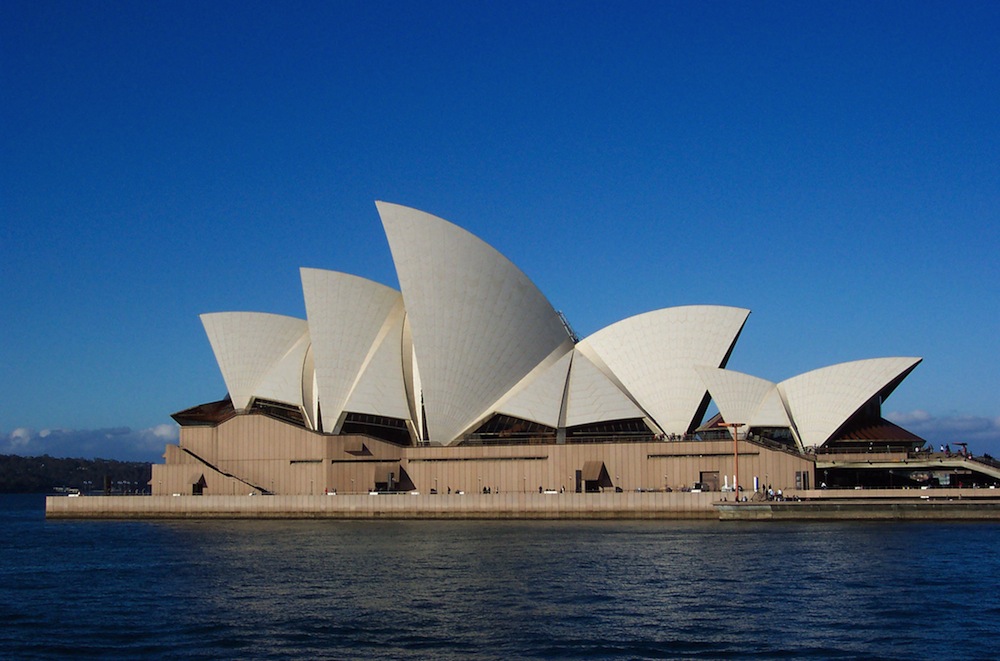When the Sydney Opera House turned 40 a few weeks ago the celebration focused on two aspects of it legacy, the building itself and the performances that took place inside underneath its sails. But there is a third facto that has gone unnoticed. The Sydney Opera House is also one of the great pieces of ceramic sculpture of the 20th century and one of the most successful marriages of tile and architecture ever.
From a distance the building seems plain white and it comes as a surprise to discover that the entire exterior is patterned. It actually features a subtle chevron pattern composed of 1,056,006 tiles of two basic types: glossy white, as well as matte cream, but made a number of tones. The tiles were manufactured by the Swedish company, Höganäs AB, which generally produced stoneware tiles for the paper-mill industry.
CFile salutes this achievement with this post, the photo essay that follows, and a presentation on The Screen about the building itself and the unbeatable razzle-dazzle of the annual Vivid Sydney projected light art festival of which the Opera House is the centerpiece-cum-screen. The projection that is featured in the video below, in which the entire building crumbles and sinks, is unforgettable. The video, Inside The Shells, is a fascinating paean to the creative spirit and imagination, you can find it at The Screen.
The building’s importance is summed up in the mission statement of the 2013 Architecture and Design Symposium in Sydney:
Perhaps no other modern building has so ambitiously, publicly and controversially embodied the connection between architecture and design as vehicles of our cultural ambitions as much as the Sydney Opera House.
Drawing together the role of design, architecture, the arts, politics, economics, public opinion and a handful of champions of cultural progress, the conditions that conspired to make the Opera House what it is today seem long past. Yet the issue of city making and the significance of developing our cultural infrastructure as embodiments of our cultural and often our national ambitions is again in sharp focus.
This begs the question, in what way would the Opera House be possible today, and how do our contemporary environments and contemporary architecture embody our cultural aspirations? What is the role of Architecture and design in shaping our cultural futures?
In 1956, the New South Wales Government called an open competition for the design of two performance halls, for opera and for symphony concerts, hoping to establish Sydney as a major city. Danish architect Jørn Utzon won the competition with an entry that consisted of a few simple sketches (made without visiting the site) that intrigued the famous Eero Saarinen, who was part of the jury, after initially being rejected by the other judges. “The drawings submitted are simple to the point of being diagrammatic,” observed the jury. “Nevertheless, we are convinced that they present a concept of an opera house that is capable of becoming one of the great buildings of the world.”
His prize was $5,000. Work started on it in 1959, with 10,000 builders employed. Mr. Utzon resigned as chief architect of the Opera House in February 1966, after a new Liberal government was elected and the Minister of Works stopped payments to him. There were protests in the streets, demanding that Utzon be reinstated, but he left Australia in April of the same year, and never returned to see his design take shape. When Queen Elizabeth II opened the Sydney Opera House on October 20, 1973, Utzon was awarded the Gold Medal of the Royal Institute of Architects Australia – but was absent from the ceremony.
Garth Clark is the Curator and Chief Editor of Cfile.
Above image: The Sydney Opera House by Danish architect Jørn Utzon in Sydney, Australia.









Jørn Utzon’s Sydney Opera House seems to be plain white from a distance; it comes as a surprise to discover that the entire exterior is patterned in a subtle chevron composed of 1,056,006 ceramic tiles.
This video documents an audiovisual staging of the Sydney Opera House that premiered May 25th, 2012, in the context of Vivid Sydney – Lighting The Sails. It is a poetic homage to the architecture and its constructional concepts by the architect, Jørn Utzon.
Visit the Vivid Sydney Festival
View videos about the Sydney Opera House on The Screen
View videos about the Vivid Sydney Festival on The Screen

The Sydney Opera House is not a ceramic sculpture.